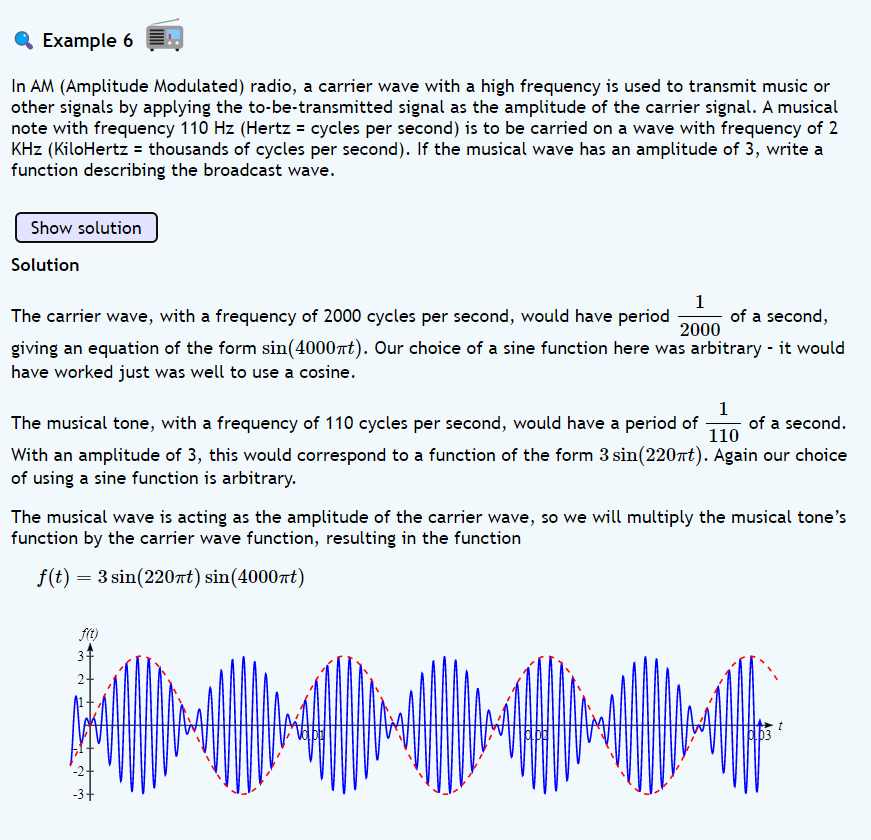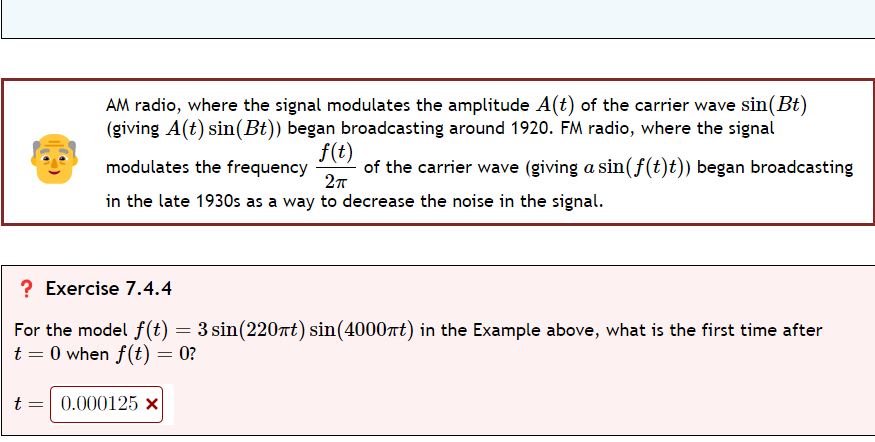Example 6 In AM (Amplitude Modulated) radio, a carrier wave with a high frequency is used to transmit music or other signals by applying the to-be-transmitted signal as the amplitude of the carrier signal. A musical note with frequency 110 Hz (Hertz = cycles per second) is to be carried on a wave with frequency of 2 KHz (KiloHertz = thousands of cycles per second). If the musical wave has an amplitude of 3, write a function describing the broadcast wave. Show solution Solution The carrier wave, with a frequency of 2000 cycles per second, would have period of a second, giving an equation of the form sin(4000πt). Our choice of a sine function here was arbitrary - it would have worked just was well to use a cosine. 1 2000 1 The musical tone, with a frequency of 110 cycles per second, would have a period of of a second. 110 With an amplitude of 3, this would correspond to a function of the form 3 sin (220πt). Again our choice of using a sine function is arbitrary. The musical wave is acting as the amplitude of the carrier wave, so we will multiply the musical tone's function by the carrier wave function, resulting in the function f(t) = 3 sin(220πt) sin(4000ft) f(t) 3 NW 6.53 t
Example 6 In AM (Amplitude Modulated) radio, a carrier wave with a high frequency is used to transmit music or other signals by applying the to-be-transmitted signal as the amplitude of the carrier signal. A musical note with frequency 110 Hz (Hertz = cycles per second) is to be carried on a wave with frequency of 2 KHz (KiloHertz = thousands of cycles per second). If the musical wave has an amplitude of 3, write a function describing the broadcast wave. Show solution Solution The carrier wave, with a frequency of 2000 cycles per second, would have period of a second, giving an equation of the form sin(4000πt). Our choice of a sine function here was arbitrary - it would have worked just was well to use a cosine. 1 2000 1 The musical tone, with a frequency of 110 cycles per second, would have a period of of a second. 110 With an amplitude of 3, this would correspond to a function of the form 3 sin (220πt). Again our choice of using a sine function is arbitrary. The musical wave is acting as the amplitude of the carrier wave, so we will multiply the musical tone's function by the carrier wave function, resulting in the function f(t) = 3 sin(220πt) sin(4000ft) f(t) 3 NW 6.53 t
Chapter6: Waves And Sound
Section: Chapter Questions
Problem 5C: An entrepreneur decides to invent and market a device that will fool the Doppler radar units used to...
Related questions
Question

Transcribed Image Text:Example 6
In AM (Amplitude Modulated) radio, a carrier wave with a high frequency is used to transmit music or
other signals by applying the to-be-transmitted signal as the amplitude of the carrier signal. A musical
note with frequency 110 Hz (Hertz = cycles per second) is to be carried on a wave with frequency of 2
KHz (KiloHertz = thousands of cycles per second). If the musical wave has an amplitude of 3, write a
function describing the broadcast wave.
Show solution
Solution
1
2000
The carrier wave, with a frequency of 2000 cycles per second, would have period of a second,
giving an equation of the form sin(4000πt). Our choice of a sine function here was arbitrary - it would
have worked just was well to use a cosine.
1
The musical tone, with a frequency of 110 cycles per second, would have a period of of a second.
110
With an amplitude of 3, this would correspond to a function of the form 3 sin(220πt). Again our choice
of using a sine function is arbitrary.
The musical wave is acting as the amplitude of the carrier wave, so we will multiply the musical tone's
function by the carrier wave function, resulting in the function
f(t) = 3 sin(220πt) sin(4000nt)
f(t)
6.53

Transcribed Image Text:AM radio, where the signal modulates the amplitude A(t) of the carrier wave sin(Bt)
(giving A(t) sin(Bt)) began broadcasting around 1920. FM radio, where the signal
f(t)
modulates the frequency of the carrier wave (giving a sin(f(t)t)) began broadcasting
2π
in the late 1930s as a way to decrease the noise in the signal.
? Exercise 7.4.4
For the model f(t) = 3 sin(220πt) sin(4000πt) in the Example above, what is the first time after
t = 0 when f(t) = 0?
t
0.000125 x
Expert Solution
This question has been solved!
Explore an expertly crafted, step-by-step solution for a thorough understanding of key concepts.
This is a popular solution!
Trending now
This is a popular solution!
Step by step
Solved in 3 steps with 3 images

Knowledge Booster
Learn more about
Need a deep-dive on the concept behind this application? Look no further. Learn more about this topic, physics and related others by exploring similar questions and additional content below.Recommended textbooks for you


Principles of Physics: A Calculus-Based Text
Physics
ISBN:
9781133104261
Author:
Raymond A. Serway, John W. Jewett
Publisher:
Cengage Learning

Physics for Scientists and Engineers with Modern …
Physics
ISBN:
9781337553292
Author:
Raymond A. Serway, John W. Jewett
Publisher:
Cengage Learning


Principles of Physics: A Calculus-Based Text
Physics
ISBN:
9781133104261
Author:
Raymond A. Serway, John W. Jewett
Publisher:
Cengage Learning

Physics for Scientists and Engineers with Modern …
Physics
ISBN:
9781337553292
Author:
Raymond A. Serway, John W. Jewett
Publisher:
Cengage Learning

Physics for Scientists and Engineers
Physics
ISBN:
9781337553278
Author:
Raymond A. Serway, John W. Jewett
Publisher:
Cengage Learning

Physics for Scientists and Engineers, Technology …
Physics
ISBN:
9781305116399
Author:
Raymond A. Serway, John W. Jewett
Publisher:
Cengage Learning

College Physics
Physics
ISBN:
9781938168000
Author:
Paul Peter Urone, Roger Hinrichs
Publisher:
OpenStax College